福建省初中英语微课一等奖——PresentContinuousTense详解26页PPT
- 格式:ppt
- 大小:2.02 MB
- 文档页数:26
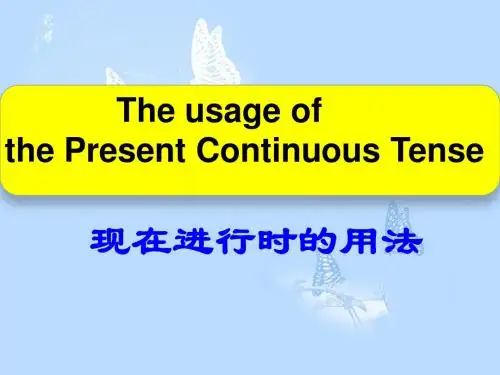
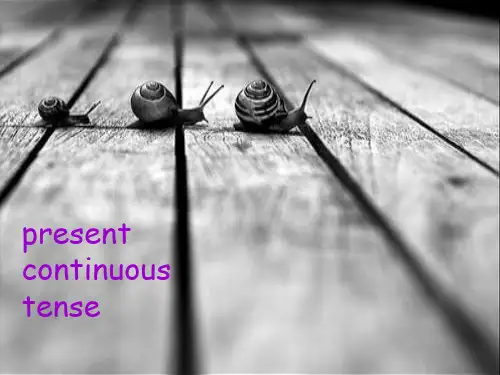
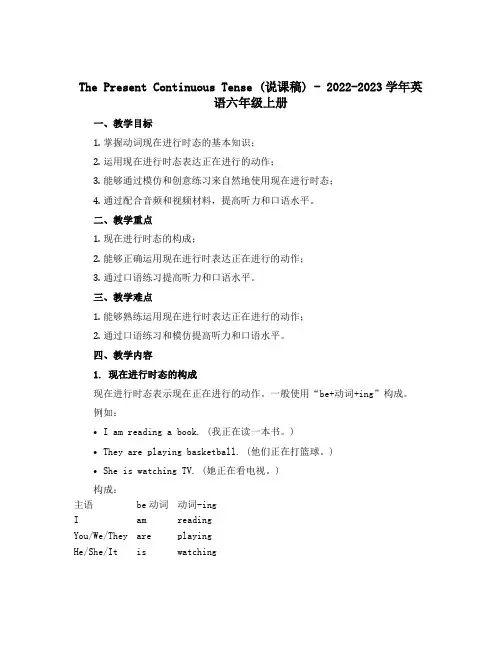
The Present Continuous Tense (说课稿) - 2022-2023学年英语六年级上册一、教学目标1.掌握动词现在进行时态的基本知识;2.运用现在进行时态表达正在进行的动作;3.能够通过模仿和创意练习来自然地使用现在进行时态;4.通过配合音频和视频材料,提高听力和口语水平。
二、教学重点1.现在进行时态的构成;2.能够正确运用现在进行时表达正在进行的动作;3.通过口语练习提高听力和口语水平。
三、教学难点1.能够熟练运用现在进行时表达正在进行的动作;2.通过口语练习和模仿提高听力和口语水平。
四、教学内容1. 现在进行时态的构成现在进行时态表示现在正在进行的动作。
一般使用“be+动词+ing”构成。
例如:•I am reading a book. (我正在读一本书。
)•They are playing basketball. (他们正在打篮球。
)•She is watching TV. (她正在看电视。
)构成:主语be动词动词-ingI am readingYou/We/They are playingHe/She/It is watching2. 现在进行时态的用法现在进行时态表示现在正在进行的动作,强调正在进行的过程,常与now、at the moment等时间状语连用。
例如:•Look! He is singing a song now. (看!他正在唱歌。
)•We are studying English at the moment. (我们正在学英语。
)3. 现在进行时态的口语练习通过以下口语练习,能够提高学生的听力和口语水平。
1.分组对话:将学生分成小组,每组两人,一人描述正在做的事情,另一人猜测描述的动作,时间为一分钟,然后换角色重复进行练习。
2.视频配对练习:播放视频,让学生听录音,跟读并模仿视频中的人物,配对猜测他们正在做什么,以此来在说出正确答案前练习口语。
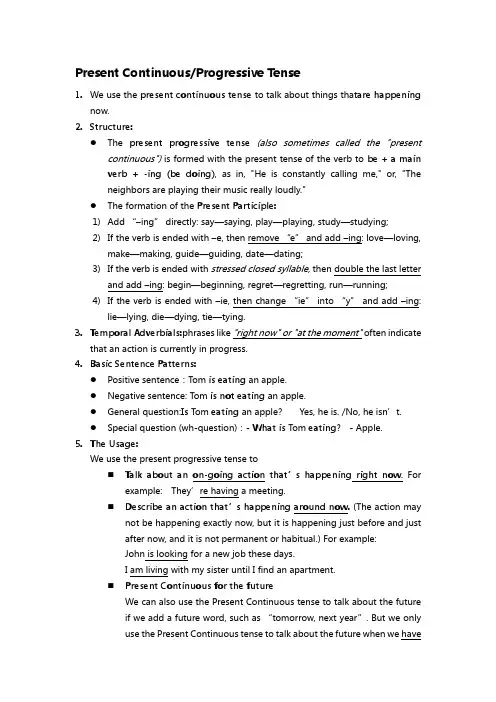
Present Continuous/Progressive Tense1.We use the present continuous tense to talk about things that are happeningnow.2.Structure:●The present progressive tense(also sometimes called the "presentcontinuous") is formed with the present tense of the verb to be + a main verb + -ing (be doing), as in, "He is constantly calling me," or, "The neighbors are playing their music really loudly."●The formation of the Present Participle:1)Add “–ing” directly: say—saying, play—playing, study—studying;2)If the verb is ended with –e, then remove “e” and add –ing: love—loving,make—making, guide—guiding, date—dating;3)If the verb is ended with stressed closed syllable, then double the last letterand add –ing: begin—beginning, regret—regretting, run—running;4)If the verb is ended with –ie, then change “ie” into “y” and add –ing:lie—lying, die—dying, tie—tying.3.Temporal Adverbials:phrases like "right now" or "at the moment" often indicatethat an action is currently in progress.4.Basic Sentence Patterns:●Positive sentence:Tom is eating an apple.●Negative sentence: Tom is not eating an apple.●General question:Is Tom eating an apple? Yes, he is. /No, he isn’t.●Special question (wh-question):- What is Tom eating? - Apple.5.The Usage:We use the present progressive tense to⏹Talk about an on-going action that’s happening right now. Forexample: They’re having a meeting.⏹Describe an action that’s happening around now. (The action maynot be happening exactly now, but it is happening just before and justafter now, and it is not permanent or habitual.) For example:John is looking for a new job these days.I am living with my sister until I find an apartment.⏹Present Continuous for the futureWe can also use the Present Continuous tense to talk about the futureif we add a future word, such as “tomorrow, next year”. But we onlyuse the Present Continuous tense to talk about the future when we haveplanned to do something before we speak. For example,I am taking my exam next month.When are you starting your new job?To complain, praise orexpress discontent when used together with words like “always, often, forever”Some students in my class are forever talking.You’re always interrupting me!She’s always helping people.Exercise1.Fill in the blanks with the present participle form of thegiven verbs.1)give________ 2)use______ 3)move_______ 4)skate________ 5)draw_________ 6)tell_______ 7)ring________ 8)wear________ 9)get________ 10)put________ 11)hit_________ 12)stop_________ 13)keep_______14)hurt________ 15)know_________ 16)lie__________17)die_________ 18)begin________ 19)forget________ 20)save________ 21)close________ 22)see_________ 23)carry_________2.Fill in the blanks with the appropriate form of the words given in thebrackets.1)Look,the boy__________(run)fast.2)--What are you doing?--I_________(do) my homework.3)Tom_______(not study)English.He is studying Chinese.4)Don’t take that ladder away. Your father’s _________(use) it.5)We __________ (spend) next winter in Australia.6)What _____ you ________(do) these days?7)We often____(buy)books and things like that in the shop.8)He _________ (arrive) tomorrow morning on the 16:40 train.9)He ______ always _________ (lose) his keys.10)Polly____(not eat) a banana now.3.Rewrite the sentences according to the requirements.1)We are having an English lesson now.Change it into a negative sentence: __________________________________________2)The woman is making a cake in the kitchen.Change is into a general question: ___________________________________________3)The baby is listening to the music.Make a special question to ask for theunderlined information:_______________________________________________________________________________4)The old man is sleeping right now.Change it into a negative sentence:__________________________________________5)The boy is waiting for his mother under the big tree.Change it into a general question: ____________________________________________6)Mary is doing her best to study English well.Change it into a negative sentence: __________________________________________ 7)She is smiling to herself in the mirror.Make a special question to ask for the underlined information:_______________________________________________________________________________ 8)The students are doing their homework now.Make a special question to ask for the underlined information:_______________________________________________________________________________。
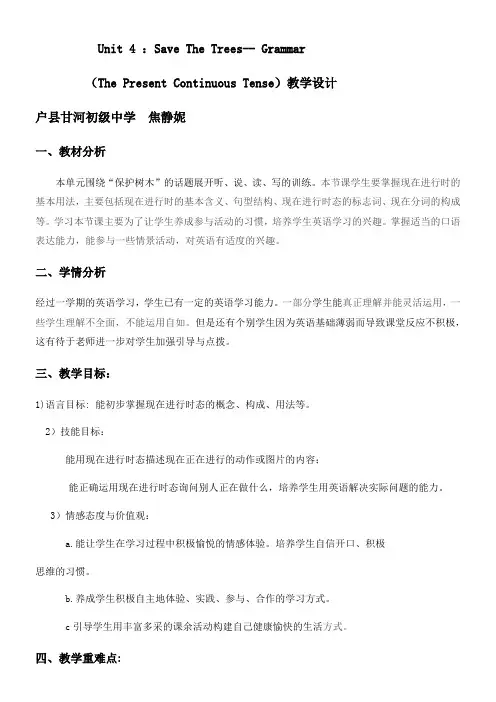
Unit 4 :Save The Trees-- Grammar(The Present Continuous Tense)教学设计户县甘河初级中学焦静妮一、教材分析本单元围绕“保护树木”的话题展开听、说、读、写的训练。
本节课学生要掌握现在进行时的基本用法,主要包括现在进行时的基本含义、句型结构、现在进行时态的标志词、现在分词的构成等。
学习本节课主要为了让学生养成参与活动的习惯,培养学生英语学习的兴趣。
掌握适当的口语表达能力,能参与一些情景活动,对英语有适度的兴趣。
二、学情分析经过一学期的英语学习,学生已有一定的英语学习能力。
一部分学生能真正理解并能灵活运用,一些学生理解不全面,不能运用自如。
但是还有个别学生因为英语基础薄弱而导致课堂反应不积极,这有待于老师进一步对学生加强引导与点拨。
三、教学目标:1)语言目标: 能初步掌握现在进行时态的概念、构成、用法等。
2)技能目标:能用现在进行时态描述现在正在进行的动作或图片的内容;能正确运用现在进行时态询问别人正在做什么,培养学生用英语解决实际问题的能力。
3)情感态度与价值观:a.能让学生在学习过程中积极愉悦的情感体验。
培养学生自信开口、积极思维的习惯。
b.养成学生积极自主地体验、实践、参与、合作的学习方式。
c引导学生用丰富多采的课余活动构建自己健康愉快的生活方式。
四、教学重难点:教学重点:现在进行时的基本用法和句型结构,口语表达能力的培养。
教学难点:现在分词的构成。
五、教学方法:讲授法对话法讨论法练习法六、教具辅助:PPT七、教学过程:1、课堂导入:①教师做出动作(看书)问:What am I doing?引导学生回答:You are reading a book.②教师做出动作(开门)问:What am I doing?引导学生回答:You are opening a door.(目的:课的开始以师生间亲切的问候导入,师生情感互融,迅速营造温馨愉悦的教学氛围,帮助师生以良好的精神状态进入课堂教学)③引导学生看PPT图片,练习What is he /she doing?“W hat are they doing?导入新课。
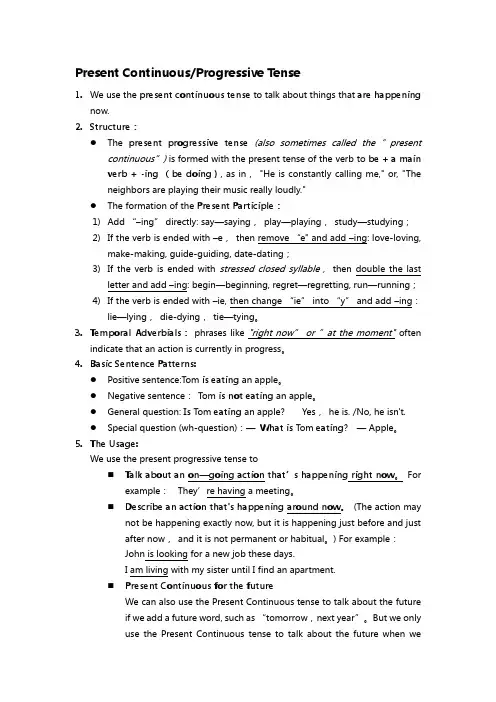
Present Continuous/Progressive Tense1.We use the present continuous tense to talk about things that are happeningnow.2.Structure:●The present progressive tense(also sometimes called the ”presentcontinuous”) is formed with the present tense of the verb to be + a main verb + -ing (be doing), as in,"He is constantly calling me," or, "The neighbors are playing their music really loudly."●The formation of the Present Participle:1)Add “–ing” directly: say—saying,play—playing,study—studying;2)If the verb is ended with –e,then remove “e" and add –ing: love-loving,make-making, guide-guiding, date-dating;3)If the verb is ended with stressed closed syllable,then double the lastletter and add –ing: begin—beginning, regret—regretting, run—running;4)If the verb is ended with –ie, then change “ie” into “y” and add –ing:lie—lying,die-dying,tie—tying。
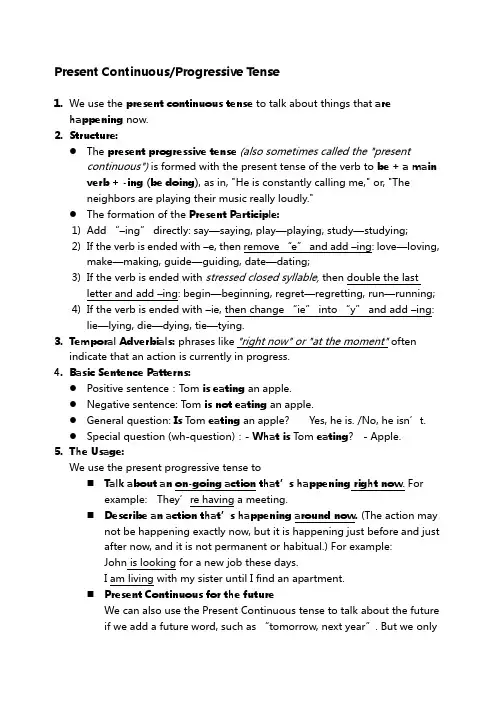
Present Continuous/Progressive Tense1.We use the present continuous tense to talk about things that arehappening now.2.Structure:●The present progressive tense (also sometimes called the "presentcontinuous") is formed with the present tense of the verb to be + a main verb + -ing (be doing), as in, "He is constantly calling me," or, "Theneighbors are playing their music really loudly."●The formation of the Present Participle:1)Add “–ing” directly: say—saying, play—playing, study—studying;2)If the verb is ended with –e, then remove “e” and add –ing: love—loving,make—making, guide—guiding, date—dating;3)If the verb is ended with stressed closed syllable, then double the lastletter and add –ing: begin—beginning, regret—regretting, run—running;4)If the verb is ended with –ie, then change “ie” into “y” and add –ing:lie—lying, die—dying, tie—tying.3.Temporal Adverbials: phrases like "right now" or "at the moment" oftenindicate that an action is currently in progress.4.Basic Sentence Patterns:●Positive sentence:T om is eating an apple.●Negative sentence: Tom is not eating an apple.●General question: Is Tom eating an apple? Yes, he is. /No, he isn’t.●Special question (wh-question):- What is Tom eating? - Apple.5.The Usage:We use the present progressive tense to⏹Talk about an on-going action that’s happening right now. Forexample: They’re having a meeting.⏹Describe an action that’s happening around now. (The action maynot be happening exactly now, but it is happening just before and justafter now, and it is not permanent or habitual.) For example:John is looking for a new job these days.I am living with my sister until I find an apartment.⏹Present Continuous for the futureWe can also use the Present Continuous tense to talk about the futureif we add a future word, such as “tomorrow, next year”. But we onlyuse the Present Continuous tense to talk about the future when wehave planned to do something before we speak. For example,I am taking my exam next month.When are you starting your new job?To complain, praise or express discontent when used together with words like “always, often, forever”Some students in my class are forever talking.You’re always interrupting me!She’s always helping people.Exercise1.Fill in the blanks with the present participle form of the given verbs.1)give________ 2)use______ 3)move_______ 4)skate________ 5)draw_________ 6)tell_______ 7)ring________ 8)wear________ 9)get________ 10)put________ 11)hit_________ 12)stop_________ 13)keep_______ 14)hurt________ 15)know_________ 16)lie__________ 17)die_________ 18)begin________ 19)forget________ 20)save________ 21)close________ 22)see_________ 23)carry_________2.Fill in the blanks with the appropriate form of the words given in thebrackets.1)Look, the boy__________ (run) fast.2)--What are you doing?--I_________ (do) my homework.3)Tom_______ (not study) English. He is studying Chinese.4)Don’t take that ladder away. Your father’s _________ (use) it.5)We __________ (spend) next winter in Australia.6)What _____ you ________ (do) these days?7)We often____ (buy) books and things like that in the shop.8)He _________ (arrive) tomorrow morning on the 16:40 train.9)He ______ always _________ (lose) his keys.10)Polly____ (not eat) a banana now.3.Rewrite the sentences according to the requirements.1)We are having an English lesson now.Change it into a negative sentence:__________________________________________2)The woman is making a cake in the kitchen.Change is into a general question:___________________________________________3)The baby is listening to the music.Make a special question to ask for the underlined information:______________________________________________________________________________ _4)The old man is sleeping right now.Change it into a negative sentence:__________________________________________5)The boy is waiting for his mother under the big tree.Change it into a general question:____________________________________________6)Mary is doing her best to study English well.Change it into a negative sentence:__________________________________________7)She is smiling to herself in the mirror.Make a special question to ask for the underlined information:______________________________________________________________________________ _8)The students are doing their homework now.Make a special question to ask for the underlined information:______________________________________________________________________________ _。
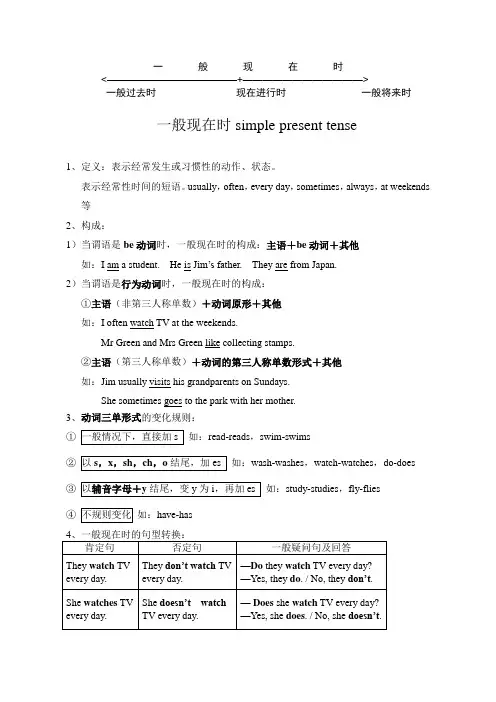
一般现在时<—————————————+————————————>一般过去时现在进行时一般将来时一般现在时simple present tense1、定义:表示经常发生或习惯性的动作、状态。
表示经常性时间的短语。
usually,often,every day,sometimes,always,at weekends 等2、构成:1)当谓语是be动词时,一般现在时的构成:主语+be动词+其他如:I am a student. He is Jim’s father. They are from Japan.2)当谓语是行为动词时,一般现在时的构成:①主语(非第三人称单数)+动词原形+其他如:I often watch TV at the weekends.Mr Green and Mrs Green like collecting stamps.②主语(第三人称单数)+动词的第三人称单数形式+其他如:Jim usually visits his grandparents on Sundays.She sometimes goes to the park with her mother.3、动词三单形式的变化规则:①如:read-reads,swim-swims②如:wash-washes,watch-watches,do-does③如:study-studies,fly-flies④如:have-has一.用下列单词的适当形式填空1.We often___________(play) in the playground.2.He _________(get) up at six o’clock.3.__________you _________(brush) your teeth every morning?4.What________________(do) he usually________________(do) after school?5.Mike sometimes __________(go) to the park with his sister.7.________ Mike________(read) English every day?8.How many lessons _________your classmates________(have) on Monday?9.What time_ ________his mother_________(do) the housework?二、单项选择。
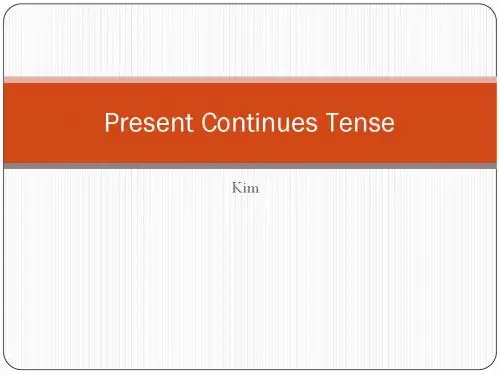

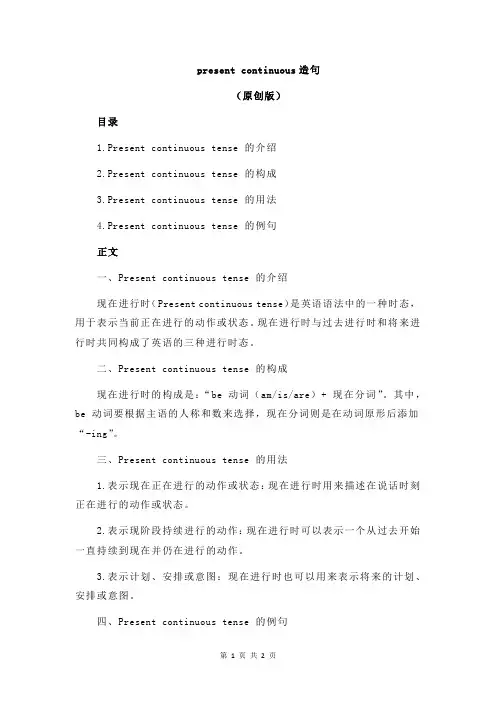
present continuous造句(原创版)目录1.Present continuous tense 的介绍2.Present continuous tense 的构成3.Present continuous tense 的用法4.Present continuous tense 的例句正文一、Present continuous tense 的介绍现在进行时(Present continuous tense)是英语语法中的一种时态,用于表示当前正在进行的动作或状态。
现在进行时与过去进行时和将来进行时共同构成了英语的三种进行时态。
二、Present continuous tense 的构成现在进行时的构成是:“be 动词(am/is/are)+ 现在分词”。
其中,be 动词要根据主语的人称和数来选择,现在分词则是在动词原形后添加“-ing”。
三、Present continuous tense 的用法1.表示现在正在进行的动作或状态:现在进行时用来描述在说话时刻正在进行的动作或状态。
2.表示现阶段持续进行的动作:现在进行时可以表示一个从过去开始一直持续到现在并仍在进行的动作。
3.表示计划、安排或意图:现在进行时也可以用来表示将来的计划、安排或意图。
四、Present continuous tense 的例句1.表示现在正在进行的动作或状态:- He is reading a book.(他正在看书。
)- She is cooking dinner.(她正在做晚饭。
)2.表示现阶段持续进行的动作:- I am learning English.(我正在学习英语。
)- They are traveling around the world.(他们正在环游世界。
)3.表示计划、安排或意图:- We are having a party next week.(我们下周要开派对。
) - They are moving to a new house next month.(他们下个月要搬到新房子。